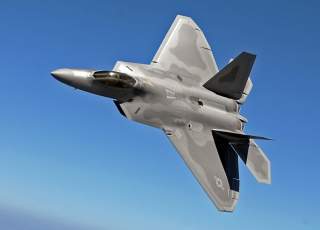Did Russia's New Radar Just Make America's Lethal Stealth Fighters Obsolete?
Nope--and we explain why.
Russia is the latest country to claim that it has developed a new radar system that can detect stealth warplanes. But the Sunflower low-frequency over-the-horizon radar likely suffers all the same drawbacks that have plagued previous generations of similar sensors.
Namely, Sunflower might be able to detect a low-observable airplane. But it probably can’t do so with great fidelity — nor generate a useful targeting track for a missile to follow. Despite Russia’s claim, stealth aircraft are no less difficult to find, target and destroy now than they were before the Sunflower’s introduction.
Russian media touted the Sunflower radar in a series of articles in early July 2016. “Russia’s powerful over-the-horizon … Sunflower radar is capable of detecting and tracking the stealth fifth-generation plane or any other fighter jet that was designed to avoid detection,” state-owned website Sputnik News reported on July 2, citing an earlier article in Svobodnaya Pressa, an independent Russian tabloid.
Sunflower and similar radars “see stealth fighter jets as clearly as World War II-era aircraft,” Svobodnaya Pressa claimed.
Technically speaking, that’s almost certainly true. Fighter-size stealth aircraft are optimized to avoid detection by radars in higher-frequency bands such as the C, X, Ku and part of the S band.
Low-frequency radars with larger wavelengths aren’t really affected by the stealth features that tend to defeat higher-frequency sensors. There’s a resonant effect with low-frequency radars that can generate a significant signal return despite an aircraft’s low-observable shaping and radar-absorbing coating.
But the same qualities that allow a low-frequency radar to detect a stealth fighter also prevent it from detecting the same aircraft with great precision. Mike Pietrucha, a former U.S. Air Force an electronic warfare officer, told editor Dave Majumdar from The National Interest that early low-frequency radars could pinpoint a target’s location to within only 10,000 feet or so — not nearly accurately enough to guide a missile.
For that reason, low-frequency radars such as Sunflower are useful only as early-warning systems. All they can do is alert air-defenders to the likely presence of low-observable aircraft in a general area.
To be fair, that’s not an insignificant contribution to a counter-air campaign. But it’s also not new. The United States, Russia, China and Iran — among other countries — have long deployed low-frequency radars for early-warning purposes.
Stealth fighters have always been visible to these sensors and always will be. Sunflower’s supposed counter-stealth prowess speaks more to the strict physical limitations of low-observable fighter-design and less to a stealth-defeating breakthrough on Russia’s part.
What’s perhaps is most impressive about Sunflower isn’t its ability to detect stealth fighters, but its comparative compactness. Many low-frequency radars installations are huge and power-intensive — and big, fat targets during a shooting war.
Sunflower, by contrast, is small and portable, according to media reports. “The system could be put online in 10 days and needs a team of just three people to stay operational,” Sputnik explained. “It does not need much power, it is easy to operate and it does not have much equipment.”
Sunflower clearly trades performance for portability. Where larger low-frequency radars can detect targets thousands of miles away, the new Russian system reportedly has a range of just 300 miles or so.
But there are clear tactical advantages in being able to quickly set up large numbers of smaller, low-frequency radars. Russia could, on short notice, deploy batteries of Sunflowers on the periphery of conflict zones in order to begin getting a vague idea of where U.S. and allied stealth fighters are operating.
That’s hardly a sure-fire way of defeating stealth. But it’s not nothing.
This first appeared in WarIsBoring here.

